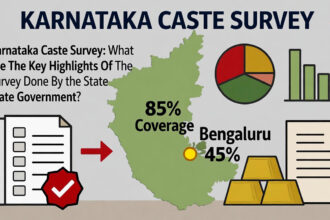
As India faces a fresh wave of U.S. imposed tariffs, a new geopolitical narrative is emerging not from Indian analysts, but from China and Russia. According to some of their top geopolitical thinkers, America’s real containment strategy is no longer focused on China it’s shifting towards India.
- From China with Concern: A Strategic Warning to India
- The Japan Trap: What Happened in the 1980s?
- Russian Perspective: The Korybko Analysis
- India’s Strategic Autonomy: A Frustration for Washington
- Beyond Products: The Need for Digital Sovereignty
- Can India Break Free of the Containment Blueprint?
- Final Thoughts
- Quick Quiz:
“The U.S. wants India to be stable and friendly, but never powerful enough to challenge its global dominance.” – Chinese geopolitical analysts, 2025
This perspective isn’t just a diplomatic jab. It’s a serious warning based on historical precedent a precedent involving Japan, the Plaza Accord, and the eventual stagnation of a once booming Asian economy.
From China with Concern: A Strategic Warning to India
Recently, Chinese state affiliated analysts and embassy spokespeople have amplified concerns that the United States is attempting to ‘contain’ India’s growth, much like it once did with Japan in the 1980s. In fact, Chinese embassy spokespeople have gone so far as to publicly declare:

India’s sovereignty is non-negotiable, and its foreign policy choices cannot be manipulated by other countries.”
Accompanying this message was a political cartoon shared by Chinese media, depicting India as an elephant being beaten by a “Tariff Stick” with the U.S. hand clearly visible. Symbolically, the Dragon (China) and the Elephant (India) are being encouraged to unite.
But why would China support India so vocally now?
Because, as per Beijing’s assessment, America has failed to contain China, and India is the new target in Washington’s long term playbook.
The Japan Trap: What Happened in the 1980s?
To understand what may lie ahead for India, we must revisit Japan’s story once predicted to surpass the United States as the world’s largest economy by the year 2000.
Instead, Japan became a cautionary tale.
Enter the Plaza Accord (1985)
The U.S. forced Japan (and other nations) to sign the Plaza Accord, which appreciated the Japanese Yen.
As a result, Japanese exports became expensive, hurting competitiveness.
A flood of cheap money led to massive asset bubbles in real estate and stock markets.
When the bubble burst, Japan entered what is now called its “Lost Decades” a period of stagnation it still hasn’t fully escaped.
Even today, Japan struggles under U.S. trade pressure. New tariffs and demands for massive investments in the U.S. have reignited friction between the allies.
Russian Perspective: The Korybko Analysis
Renowned Moscow based geopolitical analyst Andrew Korybko, a U.S. born expert, recently published an article titled:
“Trump Is Hellbent on Derailing India’s Rise as a Great Power” (Published July 31, 2025)
According to Korybko:
The U.S. doesn’t want India to collapse.
But it also doesn’t want India to emerge as a truly sovereign great power.
A middle power India, economically capped at around $6–7 trillion, suits Washington best.
The logic is clear: a powerful, independent India would no longer be easily swayed in foreign policy, trade, or defense.
Suggested Readings: Trump Imposes 25% Tariffs on India Plus Penalty from August 1
Trump Secures Exclusive U.S. Rights to Develop Zangezur Corridor in Armenia-Azerbaijan Peace Deal
India’s Strategic Autonomy: A Frustration for Washington
India’s independent stance on global issues especially its refusal to cut Russian oil imports has caused visible frustration in Washington.
Even former Pakistani Prime Minister Imran Khan acknowledged India’s autonomy in a now viral speech:
“I salute India. Despite their alliance with the U.S., they continue to act in their own national interest. That’s true sovereignty.
The U.S., in contrast, has found easier compliance from allies like Japan and Pakistan countries with limited room to defy Washington.
Beyond Products: The Need for Digital Sovereignty
This containment concern isn’t limited to trade or tariffs. Analysts are now urging India to focus on digital independence:

India needs homegrown social media platforms, OTTs, and cloud ecosystems.
What if the U.S. bans access to services like YouTube, Twitter (X), or Meta?
Data sovereignty is becoming as important as economic sovereignty.
The lack of Indian alternatives in the digital space remains a strategic vulnerability.
Can India Break Free of the Containment Blueprint?
India has already overtaken Japan in nominal GDP and become the world’s fifth largest aviation market. But the next decade will determine whether India:
Breaks into the top 3 global powers, or Plateaus like Japan under strategic, economic pressure.
The answer will depend not just on GDP numbers, but on how independently India charts its course diplomatically, economically, and technologically.
Final Thoughts
India stands at a crossroads. The US-India relationship remains vital, but sovereignty must remain non-negotiable.
It’s time for India to:
- Prioritize “Make in India”, including digital goods
- Build domestic alternatives to foreign platforms
- Continue asserting an independent foreign policy
Only then can we break free from the shadow of Japan’s fate and write our own global destiny.
Quick Quiz:
Which country recently became the world’s fifth largest aviation market?
🟩 India 🟥 Japan 🟥 Australia 🟥 USA
✅ Correct Answer: India






